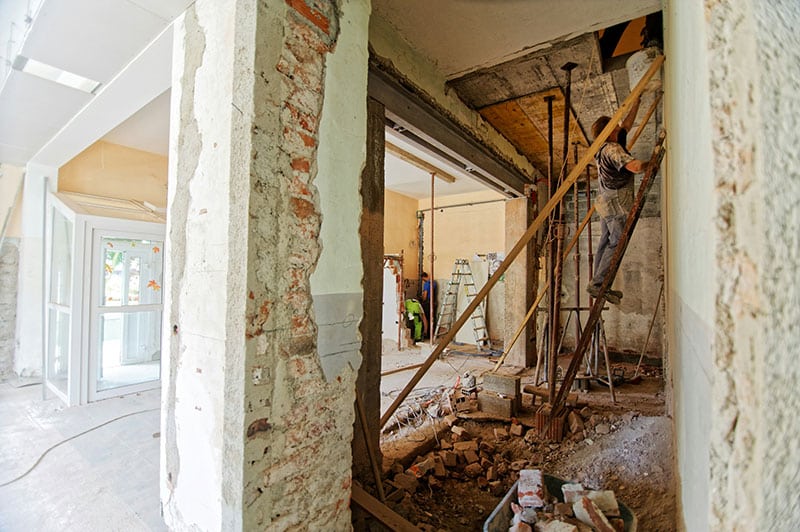How to stop worrying about asbestos
The chances are that if you are reading this, then you may be anxious about the potential effects of asbestos exposure – perhaps because you have come into contact with the substance yourself, or due to an awareness of its potential presence in your property – this is completely understandable.
After all, this naturally occurring fibrous silicate mineral is far from innocuous. It is a killer, still being responsible for around 5,000 deaths per year in the UK, even several decades after its use in this country was prohibited.
The good news, however, is that if you find yourself worrying about asbestos – whether in terms of the risks to yourself and/or someone else – there are various concrete steps you can take.

Why does asbestos cause so much anxiety?
Today, the very word “asbestos” is synonymous with severe risks to human health. However, this was not always the case. For much of the 20th century, asbestos was regarded as a miracle product, being not only relatively affordable and easy to obtain, but also physically strong, and effective at resisting heat, electricity, and fire.
It is no wonder, then, that the mineral found its way into thousands of products through the generations, seeing heavy use in such industries as construction and shipbuilding.
- First commercially mined during the mid-19th century, the mineral went on to be incorporated into asbestos cement roofing sheets, asbestos insulating board (AIB), textiles, gaskets, floor coverings, thermal insulation (lagging), and a multitude of other products.
- The legally permitted use of asbestos in the UK construction sector ceased when it was banned in 1999. However, it is believed that the lethal substance could still be present in as many as 1.5 million buildings up and down the country.
- From around the 1970s onwards, the public became ever-more aware that people who breathed in or ingested asbestos fibres were at heightened risk of developing potentially fatal health conditions in later life, such as mesothelioma or asbestos-related lung cancer. The resulting political pressures culminated in the legal restrictions eventually placed upon the use of asbestos.
You might be unsure whether your own property – whether it is a residential or non-domestic one – contains asbestos, and if so, whether you may have been exposed to it. Such uncertainty and lack of information can understandably contribute to anxiety.
This, in turn, underscores the importance of addressing such concerns with facts and action.
What are the actual risks associated with asbestos?
Various misconceptions have arisen down the years about the risks posed by asbestos. So, it is important to be aware of certain aspects of this subject, to help give you a level-headed appreciation of what those risks may be for you and/or other occupants of your building:
- The risks that asbestos poses to health typically arise when loose asbestos fibres – which are barely visible to the naked eye – are inhaled and become lodged in an exposed individual’s lungs.
- However, asbestos-related disease has a long latency period, so symptoms of such a condition often only emerge many decades after exposure.
- It is true that even a single instance of asbestos exposure can present a health risk. It is also the case, though, that most cases of asbestos-related disease occur in people who have been exposed to the substance over a prolonged period of time in occupational settings, such as construction sites.
- The mere existence of asbestos-containing materials (ACMs) in your property – presuming this is the case – does not mean your health is at risk from such materials. Indeed, if ACMs are in good condition and undisturbed, they are believed to pose negligible risk to health. Bear in mind that the condition of ACMs can change over time, with deteriorating items likely to present a higher risk.
- The exact risk levels also depend on how ACMs are managed and handled. Any disturbance of asbestos-containing products could cause loose asbestos fibres to be released into the air, and subsequently ingested or breathed in by someone nearby.
How can you identify if asbestos is present in your property?
It is important to emphasise that the task of identifying asbestos in your property cannot be done by sight alone. Even if you do see certain materials in your building that you suspect contain asbestos, by arranging to have those suspect materials sampled and analysed, you can determine whether they genuinely are ACMs.
Nonetheless, as is often said, knowledge is power. So, it can still be useful to know some things about where asbestos can be found in your property, and how to identify suspected ACMs.
- Identification of potential asbestos-containing materials (ACMs)
We have previously written in detail about the locations within a building where asbestos can be found, as well as what ACMs tend to look like.In summary, there are many different parts of a property where ACMs can be present. Some of these ACMs – such as pipe lagging and insulation – may not pose a great risk of disturbance unless the building occupant specifically seeks them out. Others, however, such as Artex textured coatings and floor tiles, are surfaces that building users may come into more regular contact with.
Such visual cues as age, material type, and location can all be telltale signs of potential asbestos presence. It is important to bear in mind, though, that asbestos comes in a broad range of shapes, sizes, and finishes. So, only the testing of a suspected ACM will be enough to confirm whether it really does contain asbestos.
- Consideration of the property’s construction date
The use of asbestos in the UK was banned in 1999, with the regulations taking effect the following year. So, if your property was constructed after the year 2000, it will be unlikely to contain asbestos.In the event, however, of your building having been constructed or renovated before the year 2000 – particularly at any point between the 1950s and the 1980s – there will be a strong chance of asbestos being present somewhere in the property’s structure.
- Why visual inspection alone is insufficient
As we stated above, it is not enough to depend on the naked eye alone as a means of identifying whether a given product does or does not contain asbestos.Genuine ACMs often closely resemble non-asbestos materials, and certain common products – such as Artex – are known to have been sold in both asbestos-containing and non-asbestos-containing versions over the years.
So, you can only be sure of the situation for your own building’s suspected ACMs if you arrange a test for them.
- The role of professional asbestos surveys
If you are worried about the potential presence of asbestos in your building and you would appreciate definitive answers and peace of mind, a professionally done asbestos survey can give you this. The resultant asbestos report will provide detailed information on the exact asbestos situation at your site, along with recommendations for subsequent actions.Three types of asbestos survey exist in the UK. One of these is the management survey, which is used for routine assessments of suspected ACMs during the property’s normal occupation and use. The other types are refurbishment or demolition surveys, which are a more intrusive and destructive inspection, designed to be carried out prior to planned works such as demolition.
If, then, the property for which you are responsible is an older building, and/or you intend to carry out renovations or similarly disruptive work at the building, a professional assessment can be especially vital for giving you certainty and the most accurate information.
What practical steps can you take to minimise worry?
Our accredited and licensed experts in asbestos management at Oracle Solutions would always advise that if you are worried about the asbestos situation at your property, you take proactive steps to exercise control.
Those moves could include:
- Commissioning an asbestos survey if you believe the material could be present
- Creating an asbestos management plan (AMP) for any identified ACMs
- Arranging regular monitoring and inspections of your site to help ensure ongoing safety
- Taking the time to learn about asbestos risks and to implement asbestos management techniques, to help improve your confidence and lessen your worry.
What should you do if asbestos is found?
In the event that you arrange an asbestos survey at your property and asbestos is confirmed to be present, there are a number of courses of action you can potentially take.
Safe options for the management of asbestos include:
- Leaving intact and undisturbed ACMs in place
- Encapsulating ACMs to prevent fibres from being released in the future
- Arranging for licensed asbestos removal contractors to remove any particularly high-risk or damaged ACMs from your property.
To reiterate a statement we made above: if you discover asbestos to be present at your premises, this doesn’t necessarily mean you are in immediate danger. The risk situation depends greatly on such aspects as the condition of the ACMs, and the likelihood of these materials being disturbed in the future.
You might be wondering at this point whether, in the event of relatively low-risk ACMs being identified at your property, you can simply remove them yourself. However, as we have written about in the past at Oracle Solutions, an untrained amateur should never attempt to do their own “DIY” asbestos removal.
There can be both health and legal reasons for this. For example, if you are responsible for a non-domestic property, you may be subject to the Control of Asbestos Regulations (CAR 2012). This legislation makes clear that in the majority of cases, it is essential for work with asbestos to be undertaken by a licensed contractor.
Plus, the DIY removal of ACMs can simply bring a high risk of asbestos fibres being accidentally released and breathed in by someone nearby – with all the associated health dangers.
What are your legal responsibilities regarding asbestos?
We cited CAR 2012 above, so we might as well elaborate a little about this legislation. It is the overarching legislation in Great Britain on how to work with asbestos, as you can read about in the Health and Safety Executive (HSE)’s publication under the L143 series code, Managing and working with asbestos.
If you are responsible for a non-domestic property and you are unfamiliar with these regulations, a good starting point is to read up on the “duty to manage” asbestos, as outlined by Regulation 4 of CAR 2012.
This “duty to manage” asbestos applies to the person in charge of maintenance for a given non-domestic premises. If this describes you, the following are all legal obligations of yours:
- Taking reasonable steps to determine whether there are ACMs in your property – and if so, to find out information about the amount, location, and condition of these materials
- Presuming that all materials in your building contain asbestos, unless there is strong evidence indicating otherwise
- Putting together an AMP, and keeping it up to date
- Regularly reviewing and monitoring your asbestos plan
- Providing details on the location and condition of ACMs to anyone who is likely to work on or disturb them.
Remember that adhering to the requirements stipulated in relevant legislation isn’t simply about minimising your liability and avoiding legal penalties. That’s because it also enables you to put in place the safety measures that will reassure you, your building’s occupants, and any affected workers.
Conclusion: how can you move forward without fear of asbestos?
We have sought to make clear in this article that while it is completely understandable to be worried about asbestos risks in your property, these concerns can be addressed with knowledge and action. The power is in your hands to begin to address these worries, whatever that may look like for your own property and circumstances.
A proactive, informed, and vigilant approach to the management of asbestos risks at your site, will help you transform fear into confidence. To find out more about our licensed asbestos services at Oracle Solutions, and to ask for a free quote, please enquire to our team today.

Written by Brendan Coleman
Brendan Coleman, with decades of experience in the asbestos industry, is a dedicated Quality Manager. Certified as a surveyor and analyst, he is adept in operations and quality management with a keen focus on HSE compliance. His expertise is pivotal in maintaining high safety and efficiency standards. Brendan ensures our UKAS accreditation requirements are consistently met and exceeded, upholding stringent standards in asbestos remediation. His commitment to enhancing quality and customer satisfaction makes him an essential advisor in asbestos management.
